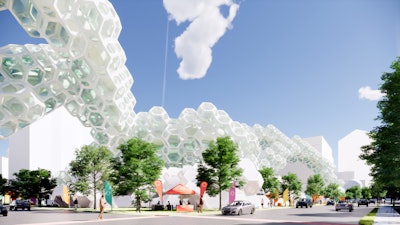
From a rooftop to the rails, the hotel of the future looks like it will be busting out of the box.
Radical Innovation, a competition for designers, hoteliers, and students in the travel and hospitality industries, recently announced the finalists for its 13th annual edition. The concepts by Danny Forster & Architecture, SB Architects, and Cooper Carry were selected from nearly 50 entries from more than 20 countries based on creativity and design, as well as their potential feasibility and ability to impact the industry.
The three firms will compete in a live pitch presentation at the New Museum in New York in October. Following that, the audience will vote to determine the grand-prize winner of $10,000 and the runner-up prize of $5,000. Plus the finalists will have the chance to meet with industry experts.
But guests won’t have to wait long to experience some of these innovative designs. One of the entries, the world's tallest modular hotel by Danny Forster & Architecture in New York, will soon be the new AC by Marriott, which is slated to open in New York’s NoMad neighborhood in early 2020.
 The new AC by Marriott, which is slated to open in New York’s NoMad neighborhood in early 2020, will be the world's tallest modular hotel.Rendering: Courtesy of Danny Forster & Architecture
The new AC by Marriott, which is slated to open in New York’s NoMad neighborhood in early 2020, will be the world's tallest modular hotel.Rendering: Courtesy of Danny Forster & Architecture A large portion of the AC by Marriott is being built off site in modules that are transported and assembled on site.Photo: Michal Lichtanski
A large portion of the AC by Marriott is being built off site in modules that are transported and assembled on site.Photo: Michal Lichtanski
The architecture firm and its tech partner patented technology that trains 3-D cameras on each module at five different points in the construction process, so that clients, contractors, and architects can keep an eye on what’s being built. It also syncs those images to the VR plans, so off-site stakeholders and on-site factory workers can compare what a module looks like at a particular stage to what it should look like.
 “We see a lot of proposals that show a creative use of space. In the last several years, we have seen a total shift away from the hotel as a traditional rectangular building,” said John Hardy, president and C.E.O. of the John Hardy Group.Rendering: Courtesy of Cooper Carry
“We see a lot of proposals that show a creative use of space. In the last several years, we have seen a total shift away from the hotel as a traditional rectangular building,” said John Hardy, president and C.E.O. of the John Hardy Group.Rendering: Courtesy of Cooper Carry Collapsible, modular units that are flexible and adaptable would fill empty in-between spaces found among buildings, parking lots, and parks.Rendering: Courtesy of Cooper Carry
Collapsible, modular units that are flexible and adaptable would fill empty in-between spaces found among buildings, parking lots, and parks.Rendering: Courtesy of Cooper Carry
“We see a lot of proposals that show a creative use of space. In the last several years, we have seen a total shift away from the hotel as a traditional rectangular building,” said John Hardy, president and C.E.O. of the John Hardy Group, which founded the Radical Innovation competition and community. “Take our Rooftop Garden concept for example. It puts guests on rooftops across all cities around the world. You don't even need to stay in the building anymore.”
 The rooftop design, by the competition’s student winners from Kazan State University of Architecture and Engineering in Russia, focuses on a conceptual hotel chain that allows guests to reserve a room on the open roof of any participating building.Rendering: Courtesy of Ruslan Mannapov and Airat Zaidullin
The rooftop design, by the competition’s student winners from Kazan State University of Architecture and Engineering in Russia, focuses on a conceptual hotel chain that allows guests to reserve a room on the open roof of any participating building.Rendering: Courtesy of Ruslan Mannapov and Airat Zaidullin
“We've already seen the connected hotels and the lobby/living rooms that function like co-working spaces,” Hardy said. Now “we're seeing a greater need to explore the farthest corners of the globe and space to have meaningful new experiences that surprise and delight us.”
 This hospitality concept aims to repurpose the American West’s defunct passenger rail lines.Rendering: Courtesy of SB Architects
This hospitality concept aims to repurpose the American West’s defunct passenger rail lines.Rendering: Courtesy of SB Architects



















